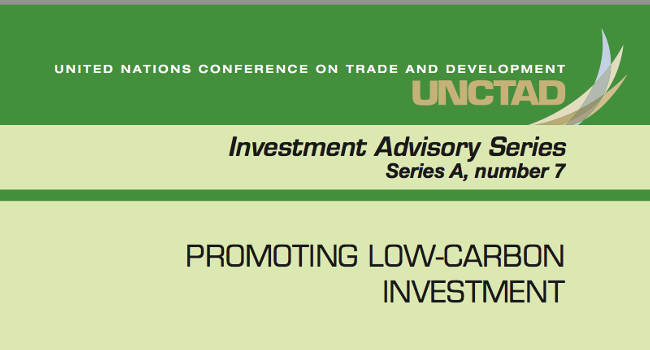
The guide aim is to help investment promotion agencies (IPAs), especially those in developing countries, to promote low-carbon foreign investment with a view to maximizing the sustainable development impact on their host economies. The focus of the publication is on practical guidelines for identifying, targeting and servicing investors in line with defined development objectives.
The rise of low-carbon foreign investment
The efforts to fight climate change have already created a wealth of new investment opportunities. It is, however, difficult to estimate the overall level of low-carbon foreign investment because investment data do not always indicate if the production processes involved or outputs produced could be defined as low carbon. When looking at greenfield investments in three major areas, i.e., alternative/renewable energy, recycling activities and environmental technology manufacturing, it can be estimated that FDI between 2003 and 2012 accumulated to close to half a trillion dollars, with a steep annual increase between 2003 and 2008 and a decline after 2008 due to the financial crisis (figure 1). Despite the crisis, the $54 billion investments in 2012 were still nearly twice the pre-crisis (2005–2007) average of $29 billion. Most projects went to developed economies, but between 2003 and 2012, not less than 44 per cent of investments were in developing and transition economies. Jobs created through these greenfield foreign investments are substantial; in the renewable energy sector alone there were an estimated 210,000 new jobs between 2003 and 2012
Companies in areas of low-carbon business, such as clean technology firms, are chasing increased international market potential, while more traditional players may be reassessing their existing investments from the low-carbon perspective. As global awareness gathers pace, low-carbon investment across sectors presents not only a business opportunity but also the chance to improve corporate image through the application of more sustainable business models.
————
In search of a lighter carbon footprint: Facebook’s data centre in cool and green Sweden
In 2011, the American social networking site Facebook decided to build its first data centre outside the United States of America, in the northern Swedish town of Luleå, to handle all data processing from Europe, the Middle East and Africa. The move will help Facebook to better serve more than one billion users, in addition to lightening its environmental footprint. This data centre will be the first to draw power primarily from renewables and will have a 70 per cent reduction in reliance on backup generators.

With Sweden being a global leader in green electricity, especially hydropower, and with data centres consuming more than 1.5 per cent of total electricity usage worldwide, Invest Sweden, the national Swedish IPA, decided to target data centres for locating in Sweden. In 2009, the agency made contact with Facebook, and that same year the online social network company invited a delegation of Swedish experts and regional representatives to its headquarters.

Given the demand from its growing international presence, Facebook was planning to expand outside the United States where it has its own data centres and leased capacity in the States of California, Oregon, North Carolina and Virginia. With the large electricity demand of its data centres, Facebook was considering a site with energy-saving systems and low-carbon power sources. Other considerations were the presence of a skilled workforce and security issues.Invest Sweden put forward a number of site proposals to assist Facebook in its decision-making process for a European data centre. In the final phases, Facebook vetted Swedish candidate locations from a list of pre-qualified sites, where Luleå and Östersund came out the strongest. In the two-year site selection period, Invest Sweden provided Facebook with continuous support, ranging from information on possible data centre sites, laws and procedures, local taxes, pricing and details of experts. The IPA helped organize site visits and meetings with potential suppliers and specialists on the energy market and connectivity. It also advised on contacts with Swedish companies and institutions.
As a result, Facebook concluded that Luleå, located just 100 km south of the Arctic Circle, offered the best package of resources, including a suitable climate for environmental cooling, clean power resources, available land, a talented regional workforce and a supportive business and corporate environment.
————
Download Full Report of Promoting Low-Carbon Investment

